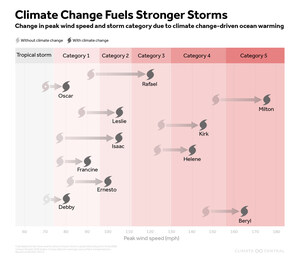As Rising Seas Threaten Hazardous Sites, California's Socially Vulnerable Communities Face Highest Risks: Study
People of color are more likely to live near sites at risk of releasing toxic chemicals during coastal floods
LOS ANGELES , May 2, 2023 /PRNewswire/ -- As climate change increases coastal flood risks at hundreds of hazardous sites in California, the potential exposure to flood-related contamination falls disproportionately on socially vulnerable and marginalized communities, according to a study released today in Environmental Science & Technology. Authored by researchers from the University of California, Los Angeles and Berkeley, and Climate Central, the study's findings are also visualized in publicly available, interactive maps by facility and by county, which overlay indicators of residents' social vulnerability near as many as 423 sites expected to be at risk of coastal flooding by 2100.
The study includes refineries, industrial facilities, sewage treatment plants, clean-up sites and other facilities that store or use hazardous material that can be released during and after coastal floods, either directly into floodwaters or to the air, land, or groundwater. Residents within one kilometer of at-risk sites were more likely than others to be people of color, to be living below the poverty line, to be unemployed, or to experience another form of social disadvantage such as linguistic isolation. Compared to their neighbors, socially vulnerable residents can face more challenges to evacuate during a flood, and often experience social stressors that can make them more susceptible to the health impacts of pollutant exposures.
"Again, climate change amplifies inequality," lead author and UCLA Fielding School of Public Health assistant professor of environmental health sciences Dr. Lara Cushing said. "Sea level rise will present additional risks of contaminant releases to communities already living with pollution sources in their backyards."
San Mateo and Alameda counties are projected to host the most at-risk hazardous sites by 2050, but by 2100 Orange County is projected to surpass both as oil and gas wells there and in Los Angeles County face rising coastal flood risks.
"Sea level rise is like a slow moving storm that we can anticipate and prepare for. As California invests in community resilience to climate change, it is essential that considerations of environmental justice are at the fore," co-author and University of California, Berkeley professor Dr. Rachel Morello-Frosch said.
"The Toxic Tides project reinforces the need for climate resilience strategies to address the disproportionate impacts of sea-level rise and associated flooding threats in environmental justice communities like Richmond and Wilmington," Amee Raval, policy and research director with the Asian Pacific Environmental Network said. "These findings will help us hold industry accountable and financially liable for cleanup and remediation of legacy toxic sites in order to protect communities from the growing risk of toxic exposure."
These projections are based on a high-emissions scenario developed by the U.N. Intergovernmental Panel on Climate Change–RCP 8.5, which assumes no meaningful reductions in carbon pollution. The number of at-risk sites in 2100 would drop to 372 under the more optimistic RCP 4.5, which assumes carbon pollution reductions roughly aligned with targets in the 2015 Paris Agreement. Projections based on both scenarios are shown in the research and the accompanying mapping tool.
Resources
Study: https://doi.org/10.1021/acs.est.2c07481
Map (facilities): https://coastal.climatecentral.org/map/6/-119.3066/37.419/?theme=flood_threats&map_type=toxic_tide_facilities
Map (counties): https://coastal.climatecentral.org/map/6/-119.3066/37.419/?theme=flood_threats&map_type=toxic_tide_regions
SOURCE Climate Central

WANT YOUR COMPANY'S NEWS FEATURED ON PRNEWSWIRE.COM?
Newsrooms &
Influencers
Digital Media
Outlets
Journalists
Opted In






Share this article